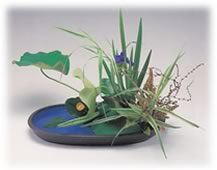
Water-reflecting Landscape Form
Source: p26
Ohara Reference Book No.19 |
|
! New !
Video lessons by the Headmaster of Ohara School of Ikebana (Hiroki Ohara) are available from the weblink below. Currently, 3 out of 5 lessons can be viewed with English subtitles:
https://hirokiohara.com/video-koza/
-------
The styles of the Ohara School fall into eight classifications
Hana-isho
Beginners in Ohara must master the basic and advanced
arrangements of Hana-isho before advancing to higher levels.
Hanakanade
This form expresses the beauty of crossing three principle stems and colour.
Hanamai
This form expresses the beauty of plants brought out by the mutual interaction in three-dimensional space. There are no rules governing the size, angle or direction of materials. To capture the sculptural beauty of the materials themselves leads naturally to the expression of three dimensional beauty in Hanamai. Therefore it is necessary to take a flexible approach and develop a good eye for the colours, forms and textures of the materials.
Moribana
One of the basic forms of Ikebana and uses flat containers. It is a highly creative form of ikebana in which all sorts of materials can be arranged freely.
Heika
One of the basic forms of Ikebana and employs tall cylindrical vases.
Rimpa
This is a type pf ikebana that is based on the highly decorative works of the Rimpa School, which flourished during the Edo Period in Japan.
Bunjin
This form of ikebana is based on a Japanese interpretation of the taste of Chinese Bunjin, or literati.
Zokei
Sculptural arrangements.
|

